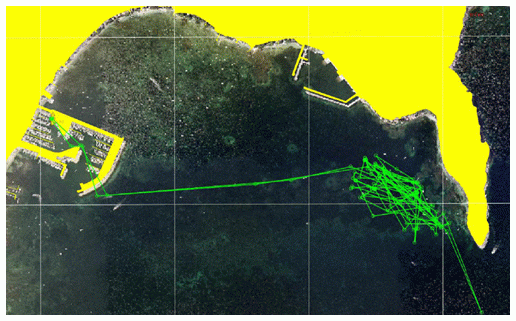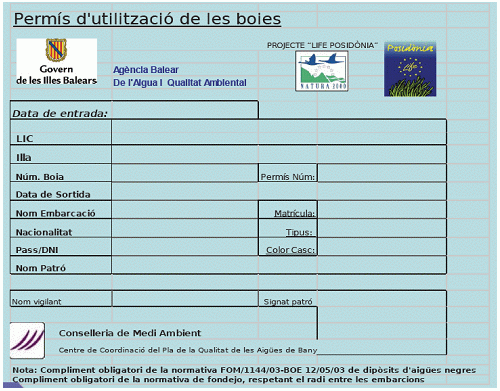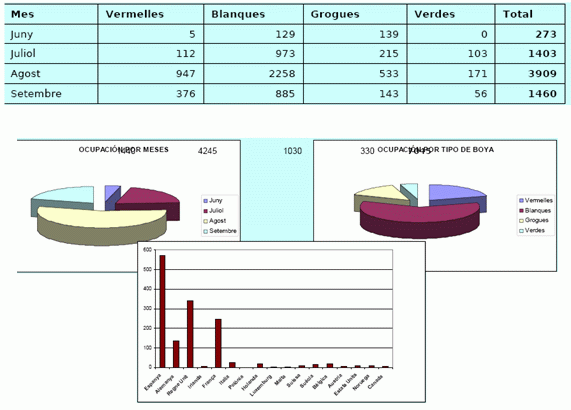Aims:
Seafarers wishing to anchor in the designated places in these areas
must require a permit. Members of the Surveillance Teams who work at
all the areas included in the project are in charge of the daily management
of the anchoring points; they check these permits and inform seafarers
about them and about the location of areas where free anchoring is allowed.
Development and Planning:
The control of the anchoring buoys is carried out by ABAQUA, through
the “Centre de Coordinació del Pla de Qualitat de les Aigües
de Bany” --Consellería de Medi Ambient-
(The Coordination Centre of the Plan for the Quality of Swimming Waters
dependent of the local Ministry of the Environment). There is a person
in charge of controlling the yachts and giving requested information
on how the anchoring areas function, and on permits: how to get them,
how long they are for, etc. The Coordination Centre has a fax, phone
and e-mail address. The person in charge is in direct contact with the
skipper of the surveillance vessel and between them they coordinate
the anchoring permits.
Each surveillance vessel carries the necessary crew to ensure that the
tasks are correctly carried out.
The SCI area of Ibiza and Formentera is controlled by two surveillance
vessels. The use of only one was not possible due to the size of the
area that had to be covered. Just in Formentera two different buoy areas
must be covered, at one of which many yachts converge thus making the
work of a single surveillance vessel very difficult. If only one surveillance
boat had had to do the work alone, it would have also had to constantly
cross the channel between Ibiza and Formentera, an activity which is
dangerous in adverse weather conditions.
Surveillance boats are at all times in constant contact with the Coordination
Centre and the Centre has real-time information on the whereabouts of
these boats through GPS.
Surveillance boats also carry a VHF communication system allowing them
to communicate with yachts wishing to anchor and nearby ports.
As for security, both the skippers and equipment of surveillance boats
comply with present legislation , as regulated by the Capitanía
Marítima (Port Authority): documents, flares, life-savers, anchor,
insurance, etc.
The surveillance boat are of the pneumatic-“zodiak” type
with rigid hull and of a length of between 5 to 6 metres.
Anchoring permits are issued by the surveillance vessel skipper.
Detailed development:
• Management is controlled by the Coordination Centre.
• Two persons are in charge of this task at the Coordination Centre.
• When a yacht requests a permit, the skipper of the yacht is asked whether he knows about the “LIFE Posidonia” project. Once this has been explained, the availability of anchoring points is determined by the surveillance boat, taking into account the length of the yacht that is requesting permission.
• If a suitable anchoring point is available, the data of the skipper and yacht are written down , as well as the number of the permit and assigned buoy. If possible these data are sent by fax or e-mail.
• Should the request for a permit be sent by fax or e-mail, it will be answered through the same means, once data has been verified.
• The skipper of the surveillance boat will later on check that the yacht is in fact correctly anchored at the assigned buoy.
• For a yacht arriving at an SCI area with no previous knowledge of the norms that apply, the skipper or a crew member of a surveillance boat will explain the “LIFE Posidonia” project, will give the skipper of the yacht written information, and will fill in an authorization form.
• Issued permits are valid for one night and may be extended if the buoy is not needed for another yacht.
• If no buoys are free, the anchoring point must be vacated and left free for a new permit application at 12 noon.
Example of the control of the route followed by a working surveillance vessel.

Use of buoy permits

Yacht registration
• Database of the Coordination Centre.
• A Gemma tracking system is planned in order to automatically follow buoy occupation.
• LIFE surveillance boats are under the control of the Coordination Centre.
• Communication with the yacht skipper is established via Movilcon in order to check buoy occupation.
Publicizing:
• Brochure containing general information on the management, and including the number and colour of buoys situated at each area as well as dates on which they may be used.
• Brochure explaining the “LIFE Posidonia” project.
• The guards explain SCI areas and anchoring norms to the yacht skippers, and the information offered is the same as that found in the website.
• At present, information is available in Catalan-Spanish and in English-German.
• Information on the location of buoys , the booking system, and the “LIFE Posidonia” project can be looked up at the Coordination Centre’s website. The information is available in Catalan-Spanish and in English-German.
Occupation of all fields by month and colour.
The period of time in which the surveillance service is operational goes
from the 1st of June to the 30th of September.

Conclusions
• Occupancy: More than 7000 yachts have used the anchoring points during this first season. That is seven thousand boats that have not ploughed the sea floor nor pulled out the Posidonia fields with their anchors and chains.
• Hitches: The guards have made a major contribution to the success of the project by explaining to yacht skippers what it is about. Their task was specially difficult in the case of S’Alga Bay, because not everybody is able to understand at first a project of this scope. Reducing to less than half the normal yacht occupancy of an area is not easy at all. The existence of a PRUG—Regulation Plan for the Use and Management, has been an invaluable help as this has allowed us to back up our words with clearly established legal norms and regulations.
• 2007: For the next sailing season we are studying ways to improve the booking system and the duration of the buoy permits. We wish to start already spreading the word from the beginning of the year so that 90 % of visitors will know about the project.